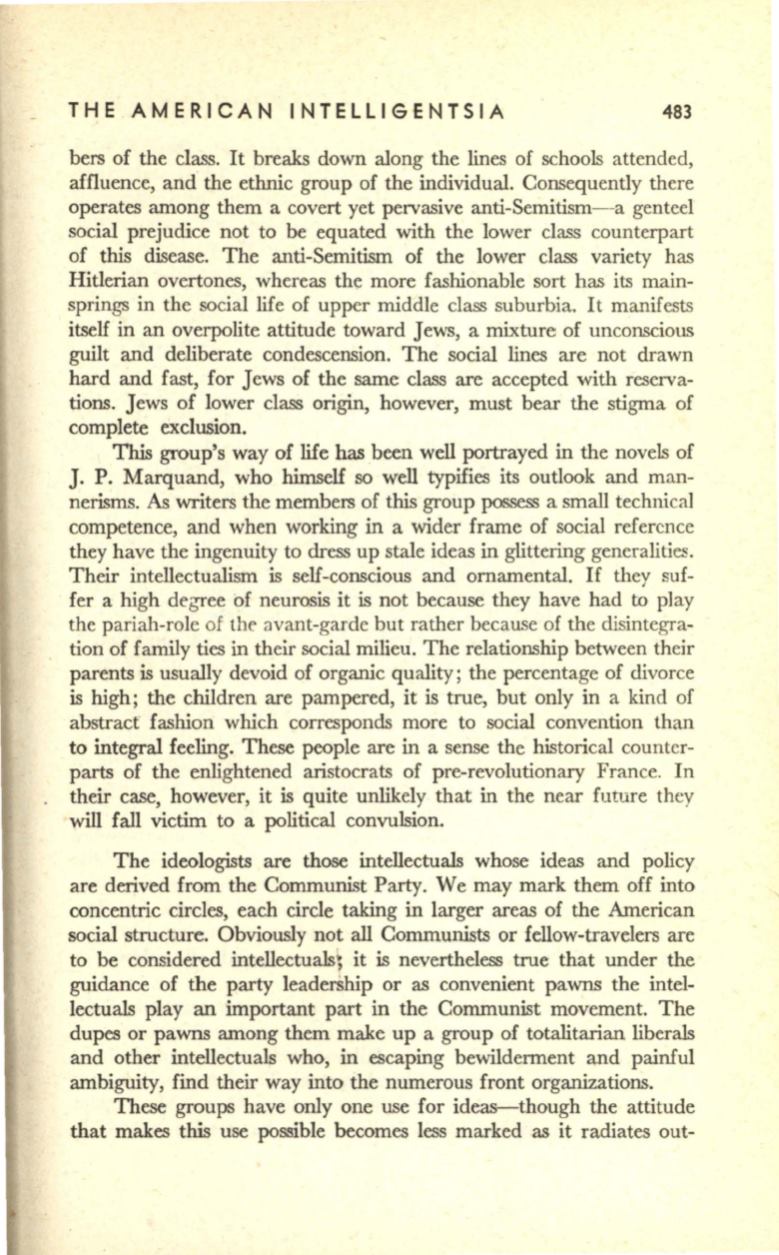
THE AMERICAN INTELLIGENTSIA
483
hers of the class. It breaks down along the lines of schools attended,
affluence, and the ethnic group of the individual. Consequently there
operates among them a covert yet pervasive anti-Semitism-a genteel
social prejudice not to be equated with the lower class counterpart
of this disease. The anti-Semitism of the lower class variety has
Hitlerian overtones, whereas the more fashionable sort has its main–
springs in the social life of upper middle class suburbia. It manifests
itself in an overpolite attitude toward Jews, a mixture of unconscious
guilt and deliberate condescension. The social lines are not drawn
hard and fast, for Jews of the same class are accepted with reserva–
tions. Jews of lower class origin, however, must bear the stigma of
complete exclusion.
This
group's way of life has been well portrayed in the novels of
J. P. Marquand, who himself so well typifies its outlook and man–
nerisms. As writers the members of this group possess a small technical
competence, and when working in a wider frame of social reference
they have the ingenuity to dress up stale ideas in glittering generalities.
Their intellectualism is self-conscious and ornamental.
If
they suf–
fer a high degree of neurosis it is not because they have had
to
play
the pariah-role of the avant-garde but rather because of the disintegra–
tion of family ties in their social milieu. The relationship between their
parents is usually devoid of organic quality; the percentage of divorce
is high; the children are pampered, it is true, but only in a kind of
abstract fashion which corresponds more to social convention than
to integral feeling. These people are in a sense the historical counter–
parts of the enlightened aristocrats of pre-revolutionary France. In
their case, however, it is quite unlikely that in the near future they
will fall victim to a political convulsion.
The ideologists are those intellectuals whose ideas and policy
are derived from the Communist Party. We may mark them off into
concentric circles, each circle taking in larger areas of the American
social structure. Obviously not all Communists or fellow-travelers are
to be considered
intellectuals~
it
is nevertheless true that under the
guidance of the party leader8hip or as convenient pawns the intel–
lectuals play an important part in the Communist movement. The
dupes or pawns among them make up a group of totalitarian liberals
and other intellectuals who, in escaping bewilderment and painful
ambiguity, find their way into the numerous front organizations.
These groups have only one use for ideas-though the attitude
that makes this use possible becomes less marked as it radiates out-


